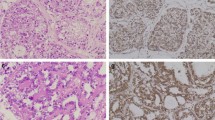Abstract
A cell line designated CUMO-2 has been established from an undifferentiated ovarian carcinoma. The s.c. injection of cells into nude mice gave rise to fast-growing tumors, while the i.p. route induced a peritoneal carcinomatosis with ascites. Histopathologically, the transplanted s.c. tumors closely resembled the original tumor, but tumors developed in the peritoneal cavity were highly anaplastic. The epithelial nature of the cells was confirmed by ultrastructural analysis. Sequential cytogenetic analyses on early and late passages revealed highly aneuploid tumor cells with consistent structural aberrations of chromosomes 1, 3, 8 and 11. CUMO-2 cells were found to produce CA 125 in vitro and in vivo. Cytosol estrogen receptor (ER) was found but progesterone receptor (PR) was not measured. HLA typing indicated the presence of DR8 and DQw4. A gonadotropin-releasing hormone (Gn-RH) analog inhibited cell growth and Gn-RH receptor mRNA was detected by reverse transcription/polymerase chain reaction in this cell line. Administration of transforming growth factor β1 inhibited both cell growth and c-myc mRNA expression. This cell line demonstrated a conformational band shift in exon 7 of thep53 gene. It was a frameshift mutation.
Similar content being viewed by others
Abbreviations
- Gn-RH :
-
gonadotropin-releasing hormone
- ER :
-
estrogen receptor
- PR :
-
progesterone receptor
- RT-PCR :
-
reverse transcription/polymerase chain reaction
- TGF :
-
transforming growth Factor
- SSCP :
-
Single-strand conformation polymorphism
- MTT :
-
3-(4,5-dimethylthiazol-2-yl)-2,5-diphenytetrazolium bromide
References
Alnemri ES, Fernandes TF, Haldar S, Croce CM, Litwack G (1992) Involvement ofBCL-2 in glucocorticoid-induced apoptosis of human pre-B-leukemias. Cancer Res 52:491–495
Askew DS, Ihle JN, Cleveland JL (1993) Activation of apoptosis associated with enforced Myc expression in myeloid progenitor cells is dominant to the suppression of apoptosis by interleukin-3 or erythropoietin. Blood 82:2079–2087
Aure JC, Hoeg K, Kolstad P (1971) Clinical and histologic studies of ovarian carcinoma: long-term follow-up of 990 cases. Obstet Gynecol 37:1–9
Buller RE, Niemann T, Connor JP, Squatrito RC, Skilling JS, Anderson B (1995) Isolation and preliminary characterization of an ovarian carcinoma cell line from a patient with familial ovarian cancer. Gynecol Oncol 56:39–44
Buchman VL, Chumakov PM, Ninkina NN, Samarian OP, Georgiev GP (1988) A variation in the structure of the protein-coding regions of the humanp53 gene. Gene 70:245–252
Chi L, Zhou W, Prikhozhan A, Flanagan C, Davidson JS, Golembo M, Illing N, Millar RP, Sealfon SC (1993) Cloning and characterization of the human GnRH receptor. Mol Cell Endocrinol 91:R1–5
Eidne KA, Flanagan CA, Harris NS, Millar RP (1987) Gonadotropin-releasing hormone (Gn-RH)-binding sites in human breast cancer cell lines and inhibitory effects of Gn-RH antagonists. J Clin Endocrinol Metab 64:425–432
Fekete M, Zalatnai A, Comaru-Schally AM, Schally AV (1989) Membrane receptors for peptides in experimental and human pancreatic cancers. Pancreas 4:521–528
Fuchtner C, Emma DA, Manetta A, Gamboa G, Bernstein R, Liao SY (1993) Characterization of a human ovarian carcinoma cell line: UCI 101. Gynecol Oncol 48:203–209
Hamilton TC, Young RC, McCoy WM, Grotzinger KR, Green JA, Chu EW, Whang-Peng J, Rogan AM, Green WR, Ozols RF (1983) Characterization of a human ovarian carcinoma cell line (NIH:OVCAR-3) with androgen and estrogen receptors. Cancer Res 43:5379–5389
Imai A, Ohno H, Iida K, Fuseya T, Furui T, Tamaya T (1994) Presence of gonadotropin-releasing hormone receptor and its messenger ribonucleic acid in endometrial carcinoma and endometrium. Gynecol Oncol 55:144–148
Kimura S, Maekawa T, Hirakawa K, Murakami A, Abe T (1995) Alteration of c-myc expression by antisense oligodeoxynucleotides enhance the induction of apoptosis in HL-60 cells. Cancer Res 55:1379–1384
Knudson AG (1993) Antioncogenes and human cancer. Proc Natl Acad Sci USA 90:10914–10921
Kunzmann R, Holzel P (1987) Karyotype alterations in human ovarian carcinoma cells during long term cultivation and nude mouse passage. Cancer Genet Cytogenet 28:201–212
Marsh GES, Bodmer JG (1992) HLA class II nucleotide sequences. In: Jsuji K, Aizawa M, Sasazuki T (eds) Proceedings of the Eleventh International Histocompatibility Workshop and Conference, vol I. Oxford Science Publications, Oxford, pp 32–62
Mulder KM, Levine AE, Hernandez X, McKnight MK, Brattain DE, Brattain MG (1988) Modulation of c-myc by transforming growth factor-β in human colon carcinoma cells. Biochem Biophys Res Commun 150:711–716
Olah E, Balogh E, Kovacs I, Kiss A (1989) Abnormalities of chromosome 1 in relation to human malignant diseases. Cancer Genet Cytogenet 43:179–194
Panani A, Ferti-Passantonopoulou A (1985) Common manker chromosomes in ovarian cancer. Cancer Genet Cytogenet 16:65–71
Pathak S (1976) Chromosome banding techniques. J Reprod Med 17:25–28
Pietenpol JA, Holt JT, Stein RW, Moses HL (1990) Transforming growth factor β-1 suppression of c-myc gene transcription: role in inhibition of keratinocyte proliferation. Proc Natl Acad Sci USA 87:3758–3762
Qayum A, Gullick W, Clayton RC, Sikora K, Waxman J (1990) The effects of gonadotropin releasing hormone analogues in prostate cancer are mediated through specific tumor receptors. Br J Cancer 62:96–99
Richadson GS, Scully RE, Nikrui N, Nelson JH (1985) Medical progress: common epithelial cancer of the ovary. N Engl J Med 312:415–424
Roberts AB, Sporn MB (1990) The transforming growth factors-β In: Sporn MB, Roberts AB (eds) Handbook of experimental pharmacology. Peptide growth factors and their receptors, Springer, New York Berlin Heidelberg, pp 419–472
Saiki RK, Bugawan TI, Horn GT, Mullis KB, Erlich HA (1986) Analysis of enzymatically amplified beta-globin and HLA-DQ alpha DNA with allele specific oligonucleotide probes. Nature 324:163–166
Sanger F, Nicklen S, Coulson AR (1977) DNA sequencing with chain terminating inhibitors. Proc Natl Acad Sci USA 74:5463–5467
Schwartz PE, Merino MJ, LiVolsi VA, Lawrence R, MacLusky N, Eisenfeld A (1985) Histopathologic correlations of estrogen and progestin receptor protein in epithelial ovarian carcinomas. Obstet Gynecol 66:428–433
Sheer D, Sheppard DM, Gorman PA, Ward B, Whelan RDH, Hill BT (1987) Cytogenetic analysis of four human ovarian carcinoma cell lines. Cancer Genet Cytogenet 26:339–349
Slotman B, Rao B (1988) Ovarian carcinoma (review). Anticancer Res 8:417–434
Smith A, Haaften-Day C, Russel P (1989) Sequential cytogenetic studies in an ovarian cancer cell line. Cancer Genet Cytogenet 38:13–24
Suzuki Y, Sekiya T, Hayashi K (1991) Allele-specific polymerase chain reaction: a method for amplification and sequence determination of a single component among a mixture of sequence variants. Anal Biochem 192:82–84
Wake N, Hreshchyhyn MM, Piver SM, Matsui S, Sandberg AA (1980) Specific cytogenetic changes in ovarian cancer involving chromosomes 6 and 14. Cancer Res 40:4512–4518
Yaginuma Y, Westphal H (1992) Abnormal structure and expression of thep53 gene in human ovarian carcinoma cell lines. Cancer Res 52:4196–4199
Author information
Authors and Affiliations
Additional information
This work was supported by a grant from the Korea research foundation, 1990
Rights and permissions
About this article
Cite this article
Kim, J.W., Lee, C.G., Lyu, M.S. et al. A new cell line from human undifferentiated carcinoma of the ovary: establishment and characterization. J Cancer Res Clin Oncol 123, 82–90 (1997). https://doi.org/10.1007/BF01269885
Received:
Accepted:
Issue Date:
DOI: https://doi.org/10.1007/BF01269885




